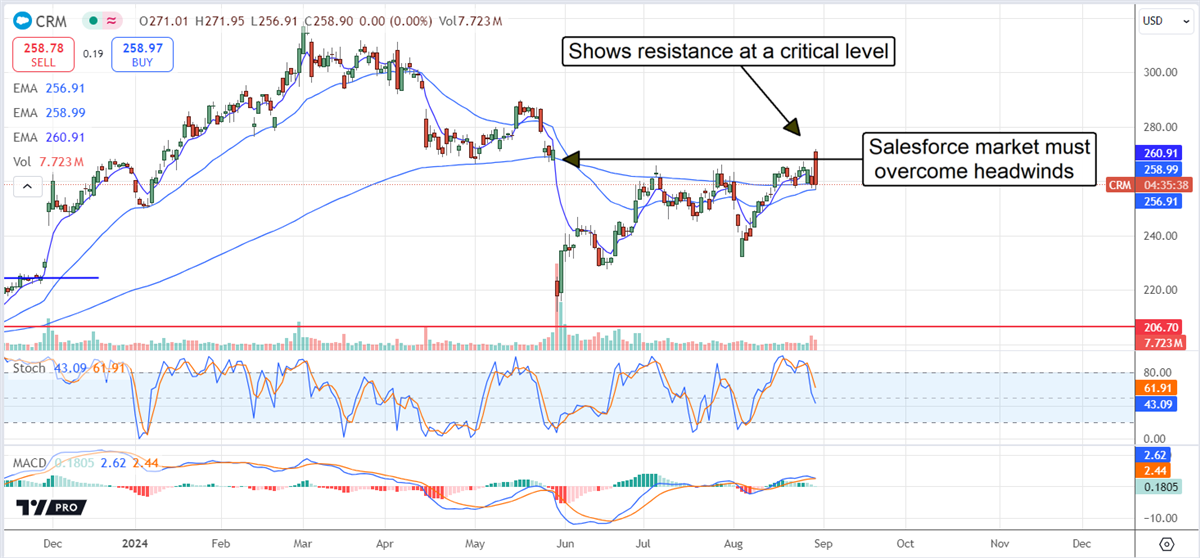The once-promising trajectory of Salesforce (NYSE:CRM) stands at a crossroads today, teetering on the precipice of a critical resistance point that threatens to shackle its ascent to new highs in the near term. Despite the glimmers of hope displayed in the company’s Q2 performance, marked by an improvement in guidance, a cloud of uncertainty looms overhead. Tentative factors such as dwindling growth rates, overarching macroeconomic conditions, and the precarious prospects of September trading dynamics contribute to this haze of doubt. Historically, the month of September has been unkind to stock markets, characterized by bouts of wild volatility and oftentimes a descent in prices, all against the backdrop of the Federal Open Market Committee’s deliberations and rising inflationary pressures.
For shrewd investors, the current consensus appears to signal a looming downturn for CRM shares in the immediate future, paving the way for a potentially opportune entry point for fresh capital infusion. Compelling at the core of this strategic outlook is the enduring promise of the company’s long-term prosperity, underpinned by the ongoing global shift towards digitization and a resolute commitment to enriching customer engagement. In a modern landscape where digitization acts as the veritable skeleton key to unlocking operational efficiency and financial viability, Salesforce’s resilient foundations indicate a robust financial position, capable of supporting both dividend payouts and share repurchases while propelling future growth initiatives.
Salesforce Braces Against Market Expectations
The recent performance of Salesforce.com during the quarter has surpassed initial estimates; however, signs of an impending plateau in growth rates set a barrier for the stock’s surge post-results. Chief among the dampeners is the tepid rise in revenue growth, clocking in at a mere 8.5% compared to previous periods, with prospects for an acceleration in 2024 appearing bleak. Furthermore, market analysts maintained a downward trajectory in their forecasts throughout the quarter, setting a modest bar for anticipated performance, thus diluting the impact of the company’s outperformance. Impressively, despite the stagnant growth scenario, Salesforce managed to significantly expand its margins across both GAAP and adjusted metrics, registering a notable uptick in operating margin levels and underpinning a double-digit boost in cash flow metrics and adjusted earnings.
The incremental uplift provided by the company’s revised guidance for Q3, forecasting a 7% growth rate, does present a silver lining amid prevailing market headwinds. However, skepticism looms due to the forecasted growth figure falling short of the consensus projections, casting doubts on the company’s full-year performance outlook. The reaffirmation of an 8.4% growth forecast for the full fiscal year, in line with Marketbeat consensus figures, serves as a somewhat stagnating factor restraining potential share price escalations.
Sustaining Value through Capital Returns
With the specter of slowing growth looming, CRM investors pivot towards assessing the sustainability of robust capital returns as the bedrock for future value. The Q2 results laid the foundation for substantial share buybacks, resulting in a notable 1.3% reduction in outstanding shares on average throughout the quarter, with this financial fortitude envisioned to persist through the year-end.
Speaking on this strategic imperative, Salesforce CFO Amy Weaver underlined, “Our capital return program remains a priority, and we now expect to more than fully offset our dilution from FY25 stock-based compensation.”
However, a looming risk for investors on the horizon may materialize from the very core of Salesforce’s current strength—its cutting-edge AI capabilities that underpin the demand for its Software as a Service (SaaS) solutions may inadvertently sow the seeds of its downfall. Despite standing as a trailblazer in the provision of essential SaaS services to businesses, the increasing trend towards in-house development of DIY (Do-It-Yourself) solutions hints at a potential shift away from reliance on external providers. Instances such as the impending abandonment of Salesforce and Workday solutions by entities like Sweden-based Klarna indicate a growing sentiment towards internal consolidation of workload management into more streamlined and scalable formats.
Limited Upside Amid Analyst Forecasts
An upsurge in stock price targets issued by Salesforce analysts in the third quarter signals a trend of cautious optimism; however, the ceiling for potential gains remains constrained. While a subset of these revised targets positions the stock at a prospective all-time high, the broader consensus veers towards a containment of potential gains in the vicinity of recent peaks. Notably, the critical price barrier at $265 stands as a formidable resistance level, poised to dictate a downward trajectory for the stock. Should this pivotal support be breached, a descent towards the $240 mark, characterized by robust underlying support, might be on the cards.

The original article “Pain for Salesforce Today: Gains for Investors Tomorrow?” first appeared on MarketBeat.